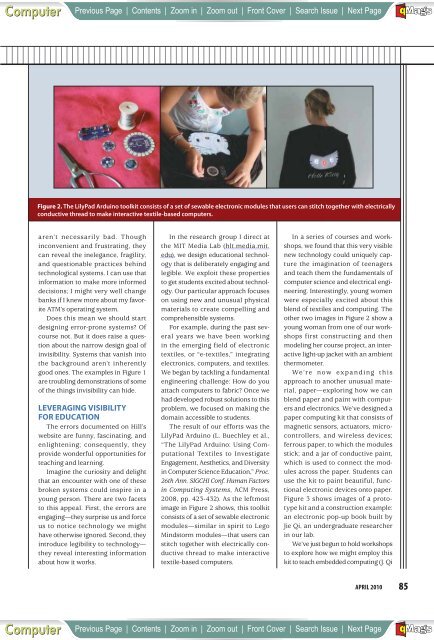computing lives - FTP Directory Listing
computing lives - FTP Directory Listing
computing lives - FTP Directory Listing
Create successful ePaper yourself
Turn your PDF publications into a flip-book with our unique Google optimized e-Paper software.
A<br />
Computer Previous Page | Contents | Zoom in | Zoom out | Front Cover | Search Issue | Next Page M S BE<br />
aG<br />
F<br />
Figure 2. The LilyPad Arduino toolkit consists of a set of sewable electronic modules that users can stitch together with electrically<br />
conductive thread to make interactive textile-based computers.<br />
aren’t necessarily bad. Though<br />
inconvenient and frustrating, they<br />
can reveal the inelegance, fragility,<br />
and questionable practices behind<br />
technological systems. I can use that<br />
information to make more informed<br />
decisions; I might very well change<br />
banks if I knew more about my favorite<br />
ATM’s operating system.<br />
Does this mean we should start<br />
designing error-prone systems? Of<br />
course not. But it does raise a question<br />
about the narrow design goal of<br />
invisibility. Systems that vanish into<br />
the background aren’t inherently<br />
good ones. The examples in Figure 1<br />
are troubling demonstrations of some<br />
of the things invisibility can hide.<br />
LEVERAGING VISIBILITY<br />
FOR EDUCATION<br />
The errors documented on Hill’s<br />
website are funny, fascinating, and<br />
enlightening; consequently, they<br />
provide wonderful opportunities for<br />
teaching and learning.<br />
Imagine the curiosity and delight<br />
that an encounter with one of these<br />
broken systems could inspire in a<br />
young person. There are two facets<br />
to this appeal. First, the errors are<br />
engaging—they surprise us and force<br />
us to notice technology we might<br />
have otherwise ignored. Second, they<br />
introduce legibility to technology—<br />
they reveal interesting information<br />
about how it works.<br />
In the research group I direct at<br />
the MIT Media Lab (hlt.media.mit.<br />
__________<br />
___ edu), we design educational technology<br />
that is deliberately engaging and<br />
legible. We exploit these properties<br />
to get students excited about technology.<br />
Our particular approach focuses<br />
on using new and unusual physical<br />
materials to create compelling and<br />
comprehensible systems.<br />
For example, during the past several<br />
years we have been working<br />
in the emerging field of electronic<br />
textiles, or “e-textiles,” integrating<br />
electronics, computers, and textiles.<br />
We began by tackling a fundamental<br />
engineering challenge: How do you<br />
attach computers to fabric? Once we<br />
had developed robust solutions to this<br />
problem, we focused on making the<br />
domain accessible to students.<br />
The result of our efforts was the<br />
LilyPad Arduino (L. Buechley et al.,<br />
“The LilyPad Arduino: Using Computational<br />
Textiles to Investigate<br />
Engagement, Aesthetics, and Diversity<br />
in Computer Science Education,” Proc.<br />
26th Ann. SIGCHI Conf. Human Factors<br />
in Computing Systems, ACM Press,<br />
2008, pp. 423-432). As the leftmost<br />
image in Figure 2 shows, this toolkit<br />
consists of a set of sewable electronic<br />
modules—similar in spirit to Lego<br />
Mindstorm modules—that users can<br />
stitch together with electrically conductive<br />
thread to make interactive<br />
textile-based computers.<br />
In a series of courses and workshops,<br />
we found that this very visible<br />
new technology could uniquely capture<br />
the imagination of teenagers<br />
and teach them the fundamentals of<br />
computer science and electrical engineering.<br />
Interestingly, young women<br />
were especially excited about this<br />
blend of textiles and <strong>computing</strong>. The<br />
other two images in Figure 2 show a<br />
young woman from one of our workshops<br />
first constructing and then<br />
modeling her course project, an interactive<br />
light-up jacket with an ambient<br />
thermometer.<br />
We’re now expanding this<br />
approach to another unusual material,<br />
paper—exploring how we can<br />
blend paper and paint with computers<br />
and electronics. We’ve designed a<br />
paper <strong>computing</strong> kit that consists of<br />
magnetic sensors, actuators, microcontrollers,<br />
and wireless devices;<br />
ferrous paper, to which the modules<br />
stick; and a jar of conductive paint,<br />
which is used to connect the modules<br />
across the paper. Students can<br />
use the kit to paint beautiful, functional<br />
electronic devices onto paper.<br />
Figure 3 shows images of a prototype<br />
kit and a construction example:<br />
an electronic pop-up book built by<br />
Jie Qi, an undergraduate researcher<br />
in our lab.<br />
We’ve just begun to hold workshops<br />
to explore how we might employ this<br />
kit to teach embedded <strong>computing</strong> (J. Qi<br />
APRIL 2010<br />
A<br />
Computer Previous Page | Contents | Zoom in | Zoom out | Front Cover | Search Issue | Next Page M S BE<br />
aG<br />
F<br />
85

















